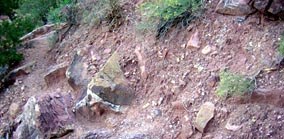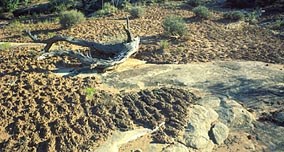
Grand Canyon National Park
Most soil types in Grand Canyon erode very easily and regenerate slowly. Their sandy nature allows water to be absorbed immediately, leaving the ground dry shortly after rain showers. The soils are typically fragile and require little disturbance to create erosional problems. Large park areas show essentially no human impacts to soils. Other areas, which were used for farming, grazing and mineral extraction, as well as developed areas, have heavily impacted soils.

USGS Canyonlands Research Station Biological crusts are highly susceptible to trampling and air pollution. Soil surveys exist for about 23% of the park (188,000 acres on the Sanup Plateau and 93,500 acres on the Havasupai Traditional Use Lands). These areas were surveyed as part of grazing allotment analyses. However, extensive soil surveys have not been conducted for much of the Canyon. he soils along the Colorado River are known in more detail. Land areas along the river are characterized by fine-grained beaches, coarse-grained cobble bars, and tributary fan deposits. The fine-grained deposits found on river terraces may be classified according their age (pre- or post- Glen Canyon Dam), how they were deposited (floods, wind action, or underwater reworking below present high water) and soil grain size (cohesive silts, and sands with negligible silt) |
An official website of the United States government
Here's how you know
Official websites use .gov
A
.gov website belongs to an official government
organization in the United States.
Secure .gov websites use HTTPS
A
lock (
) or https:// means you've safely connected to
the .gov website. Share sensitive information only on official,
secure websites.
